
Assisi is a town and comune of Italy in the Province of Perugia in the Umbria region, on the western flank of Monte Subasio.
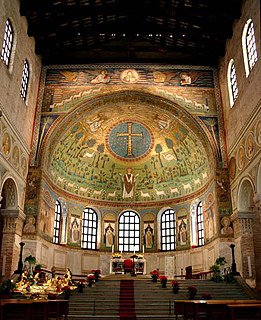
In architecture, an apse is a semicircular recess covered with a hemispherical vault or semi-dome, also known as an exedra. In Byzantine, Romanesque, and Gothic Christian church architecture, the term is applied to a semi-circular or polygonal termination of the main building at the liturgical east end, regardless of the shape of the roof, which may be flat, sloping, domed, or hemispherical. Smaller apses are found elsewhere, especially in shrines.

Grado is a town and comune of 8 064 residents in the north-eastern Italian region of Friuli-Venezia Giulia, located on an island and adjacent peninsula of the Adriatic Sea between Venice and Trieste. The territory of the municipality of Grado extends between the mouth of the Isonzo and the Adriatic Sea and the lagoon of the same name which covers an area of about 90 square kilometers and goes from Porto Buso to Fossalon. Characteristic of the lagoon is the presence of the casoni, which are simple houses with thatched roof used in the past by the fishermen of Grado, who remained in the lagoon for a long time, returning to the island of Grado only during the colder period of the year.
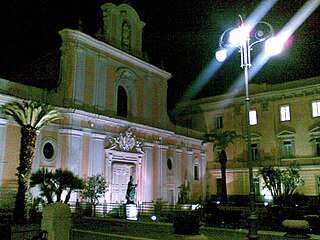
Santa Maria Capua Vetere is a town and comune in the province of Caserta, part of the region of Campania.

One of the first streams of Romanesque architecture in Europe from the 10th century and the beginning of 11th century is called First Romanesque or Lombard Romanesque. It took place in the region of Lombardy and spread into Catalonia and into the south of France. Its principal decoration for the exterior, bands of ornamental blind arches are called Lombard bands. It was characterized by thick walls and lack of sculpture in facades, and with interiors profusely painted with frescoes.

Bonate Sotto is a comune (municipality) in the Province of Bergamo in the Italian region of Lombardy, located about 40 kilometres (25 mi) northeast of Milan and about 9 kilometres (6 mi) southwest of Bergamo in the Isola bergamasca.

Treviolo is a comune (municipality) in the Province of Bergamo in the Italian region of Lombardy, located about 40 kilometres (25 mi) northeast of Milan and about 7 kilometres (4 mi) southwest of Bergamo. As of 1 January 2011, it had a population of 10,363 and an area of 8.7 square kilometres (3.4 sq mi).

The Basilica of Sant'Ambrogio is a church in the centre of Milan, northern Italy.
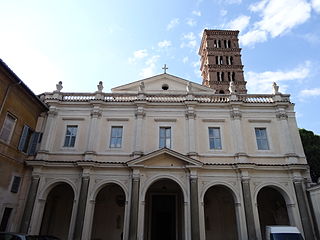
The Basilica dei Santi Bonifacio e(d) Alessio is a basilica, rectory church served by the Somaschans, and titular church for a cardinal-priest on the Aventine Hill in the third prefecture of central Rome, Italy.

The basilica of San Vincenzo in Prato is a church in Milan, northern Italy. It is the only one in city which has entirely maintained its original Palaeo-Christian appearance.

San Salvatore is a former monastery in Brescia, Lombardy, northern Italy, now turned into a museum. The monastic complex is famous for the diversity of its architecture which include Roman remains and significant pre-Romanesque, Romanesque and Renaissance buildings.
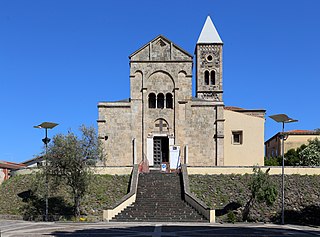
Santa Giusta Cathedral, now a minor basilica is the former cathedral of the abolished Diocese of Santa Giusta, in Santa Giusta, province of Oristano, Sardinia, Italy. The dedication is to Saint Justa of Cagliari who, according to the tradition, was martyred here at the time of the Roman emperor Diocletian, with her companions Saints Justina and Aenidina. Almost entirely built in sandstone, it is considered one of the most important examples of Sardinian Romanesque architecture.

The Oratorio di San Protaso is a church in via Lorenteggio, Milan, Lombardy.

Lombard architecture refers to the architecture of the Kingdom of the Lombards, which lasted from 568 to 774 and which was commissioned by Lombard kings and dukes.

Santa Sofia is a Roman Catholic church in the town of Benevento, in the region of Campania, in southern Italy; founded in the late-8th century, it retains many elements of its original Lombard architecture.

Longobards in Italy: Places of Power is seven groups of historic buildings that reflect the achievements of the Germanic tribe of the Lombards, who settled in Italy during the sixth century and established a Lombard Kingdom which ended in 774 A.D.

The Basilica of Sant'Eufemia is a minor basilica in Grado, Friuli-Venezia Giulia, Italy, formerly a cathedral. It is dedicated to Saint Euphemia.

Brescia is a city and comune in the region of Lombardy in Northern Italy. It is situated at the foot of the Alps, a few kilometres from the lakes Garda and Iseo. With a population of more than 200,000, it is the second largest city in the region and the fourth of northwest Italy. The urban area of Brescia extends beyond the administrative city limits and has a population of 672,822, while over 1.5 million people live in its metropolitan area. The city is the administrative capital of the Province of Brescia, one of the largest in Italy, with over 1,200,000 inhabitants.
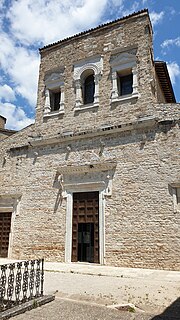
San Salvatore is a romanesque-style, former basilica church located in the center of Spoleto, Province of Perugia, region of Umbria, Italy.

The Basilica of Santa Maria at Pie' di Chienti was a former Roman Catholic monastery and church located in a rural site on the north bank of the Chienti river, just outside of the town of Montecosaro Scalo, in the province of Macerata, region of Marche, Italy. The church is also known as the Santissima Annunziata.




















